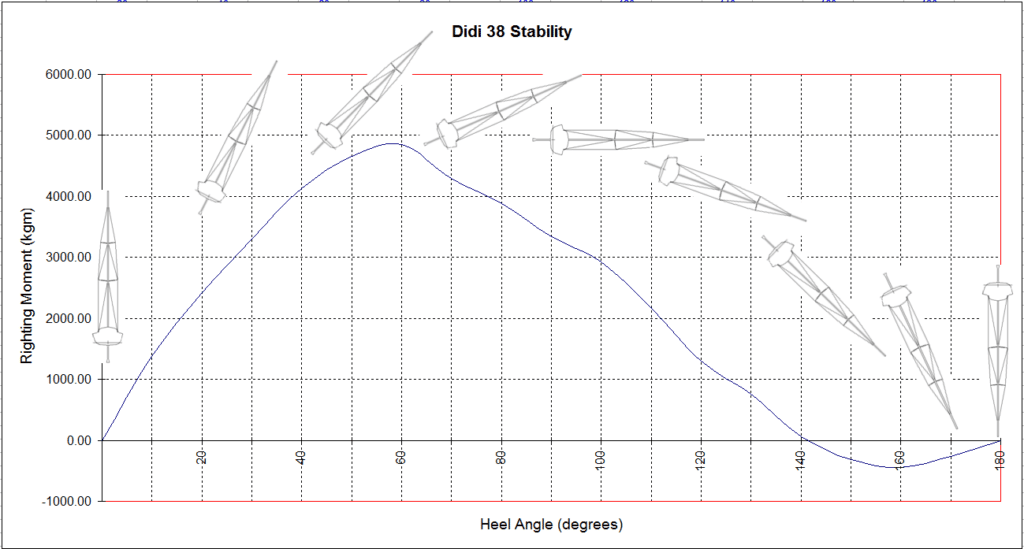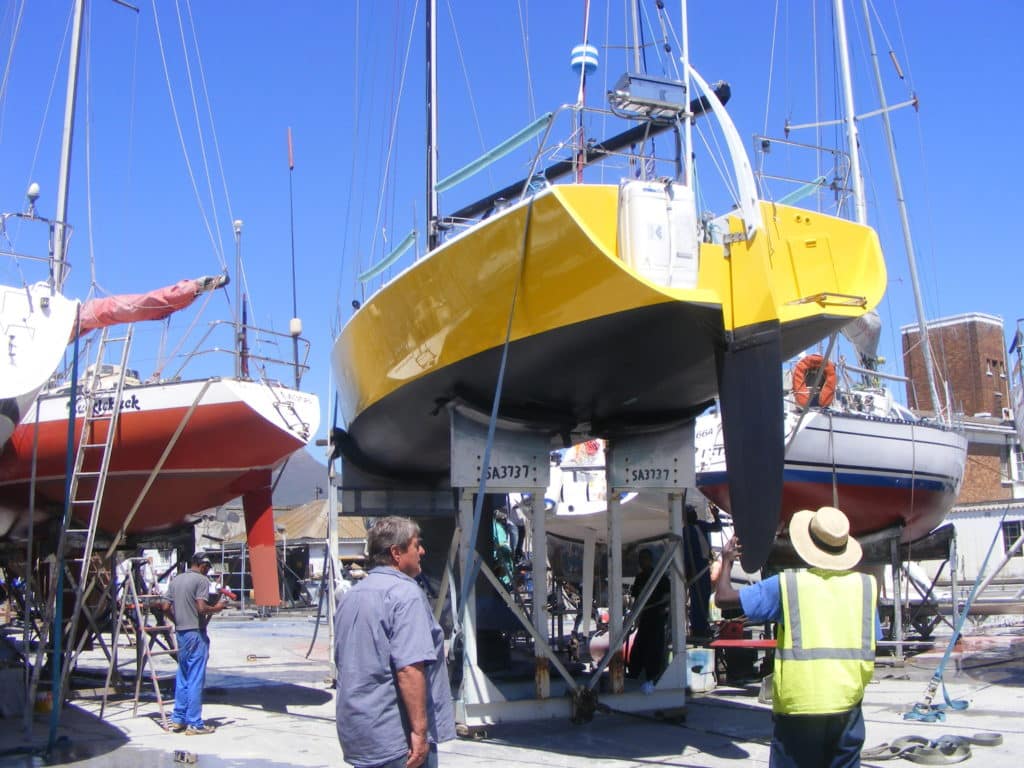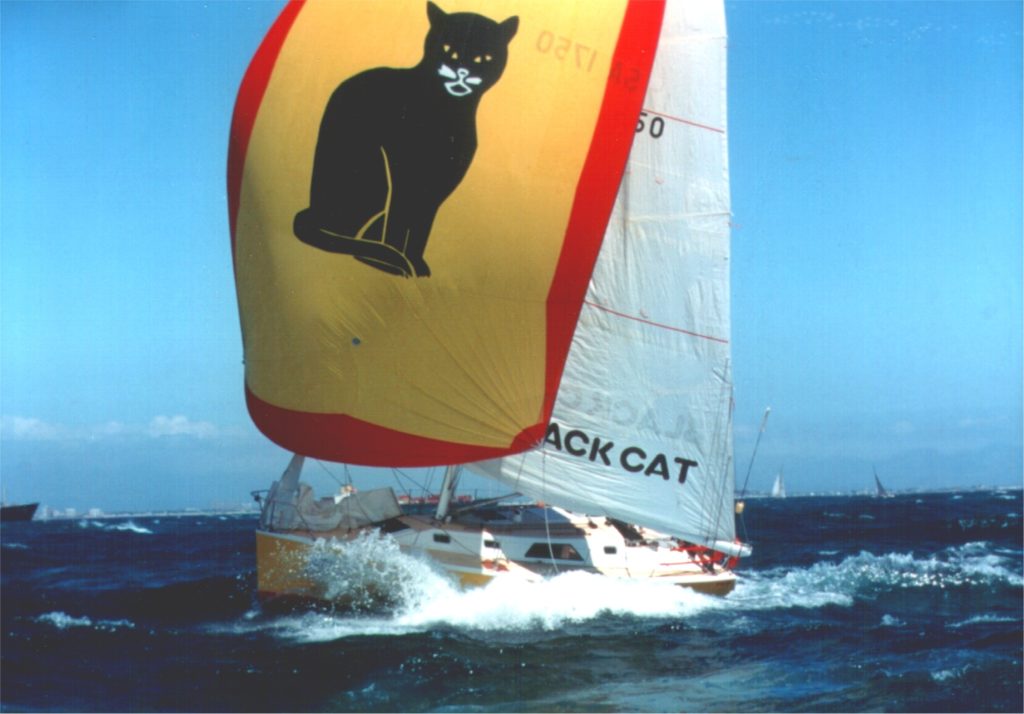The importance of a good range of positive stability and a high ratio of positive to negative stability cannot be over-emphasized. Black Cat is a fairly slim boat by modern standards, with a deep bulb keel, fairly high freeboard and considerable volume in her trunk cabin. This combination creates a boat with high angle of vanishing stability and minimal negative stability. These features can be seen in her stability curve.
From the start of our capsize to back upright took no more than 10 seconds. In that time enough water entered to drown the electrics. I would not like to be in a boat that is inverted for a minute or two, as is likely to happen with a boat that has a much larger range of negative stability. A beamy boat with a low angle of vanishing stability could be inverted for 10 minutes or more, which would leave it at considerable risk of sinking, whether or not it rights itself. Bearing in mind that there was only the one big tubing wave on an otherwise less violent ocean, a boat with low angle of vanishing stability may well have stayed inverted indefinitely because there would not have been another similar wave to bring her back to upright.
I would like to discuss the basic principle of sailboat stability in big breaking waves. Don’t consider this as a treatise on the subject, it is merely my knowledge, gathered over many years, some of it from personal experience and some of it from reading people much more technically knowledgeable than I am. For anyone who wants to read technical material on the subject, I recommend the mighty tome Aero-Hydrodynamics of Sailing, by C.A.Marchaj (ISBN 0 229 98652 8) and Seaworthiness – The Forgotten Factor (ISBN 0 229 11673 6), by the same author. I don’t agree fully with some of the conclusions drawn by the author in the latter book, but it is a worthwhile read nevertheless.
Sailboats vary in infinite combinations of characteristics. These include the full range of values for:
• Displacement
• Beam
• Form stability
• Ballast stability
• Freeboard
• Moment of inertia
• Immersed lateral plane
• Superstructure volume
Depending on the exact combination of characteristics that come together in any particular boat, it will affect how the boat behaves. Two boats may look similar but if they are not identical in every way, they will behave differently when broadside to big waves. I am going to generalize when discussing these characteristics because the effect of every one of them is affected by every other characteristic on my list.
A light displacement boat is easily moved by whatever forces are applied to it; a heavy boat needs more force to be applied to it to produce the same reaction, even if the center of gravity (CG) of each is in the same place. This is primarily because the light boat has a low moment of inertia value and the heavy boat has a high moment of inertia value. The heavy boat is less likely to be rolled by a wave because it takes more effort to get the boat to start rotating. However, once the heavy boat starts to rotate it will also take more force to stop the rotation.
Black Cat started to capsize quickly because she is light, but for the same reason the rotation stopped quickly when the deck hit the water. A heavy boat may not have capsized as easily but may have gone all the way round instead of reversing direction after landing. Beam affects interior space and sail-carrying power but beam will also increase the amount of negative stability that will slow the recovery from a capsize.
A boat with slack bilges, wineglass sections and full keel has low form stability and another of the same beam but with shallow underbody, firm bilges and fin keel has high form stability. The boat with low form stability is somewhat like a semi-spherical glass bowl if you float it in a bath of water. Kick up a storm in the water and the bowl will stay fairly upright on the moving water. Let the water settle and then push down on one edge of the bowl then let it go and the bowl with rock back and forth for a while. In contrast the boat with high form stability is more like a flat cutting board floating in that same bath. Roughen up the water and the board jumps around, staying flat against the moving surface of the water. Let the water settle then push down on one edge of the board and it returns very quickly to horizontal. In reality all boats will fit somewhere between the bowl and board extremes but tend toward one or other side of the average.

Didi 38 Stability Curve
The boat with slack bilges tends to stay fairly upright when a long swell passes under it. However, once it gets moving there is not much to stop it, so it can get into harmonic rhythm with the waves and roll very heavily. It can become very uncomfortable, difficult to sail in light breezes with big seas and can throw itself into a capsize if a wave breaks against it at the same time as it is already rolling itself in the direction that the wave will roll it.
The boat with high form stability tries its best to keep the designed waterline (DWL) parallel to the water surface, so the boat has a fairly sharp motion as the waves move past underneath it. It rolls in a very regular manner, closely aligned to the passing of the waves. It is not likely to get into the harmonic rolling scenario of the boat with low form stability. If it does capsize it will be from the hull rotating as it tries to keep DWL parallel to the steepening face of the wave.
Black Cat has high form stability. That is why she rotated to well past 90 degrees on the surface of the tubing wave.
Ballast stability is associated with form stability but it is an inverse relationship. A boat with low ballast stability has to have high form stability if it is to have the power needed to carry a good spread of sail in reasonable breeze. A boat with high ballast stability can have form stability anywhere in the range from low to high. It needs a strong rig if high form stability and high ballast stability are combined. High ballast stability comes from locating the ballast to give a low overall center of gravity to the boat. This can be from a large amount of weight fairly close to the hull in a shallow keel or a smaller amount of weight in a bulb at the end of a deep keel, or anything between those two extremes.
High ballast stability helps to keep a boat more upright on the face of the wave, whether it has low or high form stability, reducing the chances of capsize. Black Cat has a bulb keel and 50-percent ballast ratio, so has high ballast stability.
A boat with low freeboard presents less area for a breaking wave to act on than one with high freeboard. More of the wave will flow over the top of a low freeboard boat than a high freeboard boat, so less impact energy will be applied to the low freeboard boat, resulting in less energy trying to push it over. In balance (nothing ever comes for free in boat design), the low freeboard boat is more likely to immerse the leeward deck edge as it slides down the face of a wave, so it is more likely to be tripped into a roll-over. Increasing freeboard increases the angle of vanishing stability, which extends the range of positive stability and reduces the range of negative stability.
Black Cat, with her light displacement, shallow hull and full standing headroom, has fairly high freeboard. This may have increased the wave energy acting on her in this capsize but also allowed her to skate down the wave away from danger in her 1996 knockdown.
A boat with high moment of inertia value takes more energy to rotate it than a boat with low inertia. When a breaking wave hits a boat it applies lateral force through the forward movement of the wave, rotational forces through the circular movements of the solid water within the wave and an angular force from impact of any white water that is sliding down the face of the wave. When a boat is subjected to these combined forces, the boat with high inertia will have a tendency to be moved bodily sideways and stay upright, while the boat with less inertia will tend to rotate more easily and might be rolled.
Heavy boats have high inertia values and light boats have low inertia values, due to the mass component in the inertia calculation. But moment of inertia is not only a matter of weight, it is also how the weight is distributed, whether concentrated or spread out. The position and mass of any weight in the boat affects the total moment of inertia of the boat as a whole. The greater the mass and the further that it is from the center of gravity of the boat, vertically or laterally, the more that it will increase the transverse moment of inertia of the boat. Heavy ballast low down increases inertia considerably, as does a heavy mast because they are a long way from the center of gravity of the boat. A pair of large water tanks against the hull sides results in greater inertia than a single tank of the same total capacity on centerline, for the same reason. A pair of diesel engines well off centerline offers more inertia than a single engine of equal weight on centerline. A sailboat that has lost its rig is more likely to be rolled than the same boat with the rig intact. This is not because it has lost stability, it has actually gained stability without the top-weight of the rig. It is because the inertia of the boat without its rig is much less than it was before the rig was lost.
Immersed lateral plane area is a measure of the profile area of the hull below waterline, i.e. viewed from the side. This area submerged below the water provides resistance to the boat being knocked sideways by the top of the wave breaking against the topsides of the hull and the superstructure. A full keel cruising boat with deeply veed hull has a lot more lateral plane area than a shallow-bodied racer with high aspect fin keel and spade rudder. This extra lateral area increases the chances of the cruiser being rolled by a breaking wave instead of sliding sideways.
Superstructure acts in multiple ways in the capsize situation. The profile area of the superstructure increases available impact area for the breaking wave to push against in its efforts to start the rotation process of the capsize. The other side of that superstructure will act to slow the rate of capsize when it impacts the water on the leeward side. The actual volume of the superstructure above deck level works to return the boat to upright if it is capsized. The greater the superstructure volume and the more rounded its shape in cross-section, the more effective that volume is in returning the boat to upright. This is the principle used for the design of self-righting lifeboats and rescue craft.
Superstructure volume is a major factor in reducing the area below the zero line on a stability curve. This means that it reduces the amount of energy needed to get the boat back to the point of vanishing stability so that it can rotate back to upright. This translates directly into reduced time upside-down, with resulting reduction in water entry through hatches, ventilators etc and an improvement in the chances of survival for the crew, whether inside the boat or on deck. If the boat is upright again in seconds then there is no time for the crew to wonder if it is going to happen; they are still hanging on due to the capsize when the boat rights itself.

Didi 38, Black Cat
If the boat takes more than a minute or two to right itself then the crew who are inside will be wondering how to get out safely and anyone in the cockpit could be struggling with a tangle of halyards and sheets that prevents them from surfacing next to the boat for air. Trapped by lines or a self-inflating lifejacket, crew can be quickly drowned. Beyond five minutes inverted, those in the cabin will realize that they cannot rely on the boat righting itself and will have to make their way through the mess of lines in the cockpit, with the same risks as those faced by the crew who were in the cockpit when the boat capsized. A light displacement boat with flush deck is likely to have a stability curve with large area below the zero line and to stay inverted for a long time, with considerably increased danger to the crew. Black Cat has a fairly large cabin structure that is heavily cambered, which helped her to return to upright very quickly. Along with all of this, the structure of the boat has to be solid enough to withstand the loads applied by the impacts between boat and water. This is not normally a problem for the hull, which is designed for impacts with waves. For boats of traditional wood construction the most likely damage in a massive knock-down or capsize is not on the windward side where the initial wave impact takes place, it is fracturing of the cabin on the leeward side or bursting of the windows in the leeward cabin side, due to impact with the water as the boat rolls the leeward side into the water.
Due to the mode of capsize that we experienced, the impact with the water that Black Cat had to withstand was mostly with the roof and starboard side of the cabin, the remainder being with the starboard side decks and foredeck. Scantling rules use varying pressures for different parts of the boat, the highest pressures being in the bottom panels forward of the mast and reducing further aft and/or higher on the hull. Decks, cockpits and cabin fronts are lower pressures than the hull and the lowest pressures are for the top, sides and aft end of the cabin. This is a logical arrangement, yet there we were, falling multiple stories and cabin-first to make a big impact with the sloping face toward the bottom of the wave. Inspection of the structure showed only minimal damage in the form of a single fine vertical hairline crack in the mast bulkhead and attached roof beam above the door opening, which will be easily repaired. In retrospect, there is only one term that comes to mind to properly describe what happened to Black Cat. Nature sent a big wave that performed a slam-dunk. She was picked up, turned over, slammed down and dunked. For us inside the boat it was all noise and upside-downness. My crew and I know that we came off lightly. Considering what happened to us, it could have been considerably worse.
What have I taken out of this capsize experience? First, it is validation of my long-held belief in offshore boats that have a large angle of vanishing stability combined with minimal negative stability. That requires sensible freeboard and reasonable cabin volume, working along with low CG. I design for all materials but the bulk of design commissions that come my way are for plywood boats for amateur builders. This experience gives validation of the structural integrity of lightweight plywood construction.
Most of all, I expect the experience to always be in the back of my mind, influencing decisions taken in all future offshore designs that I draw. Broad on the water experience is invaluable for a boat designer and tumbling inside a capsizing boat is now indelibly included in those experiences.









